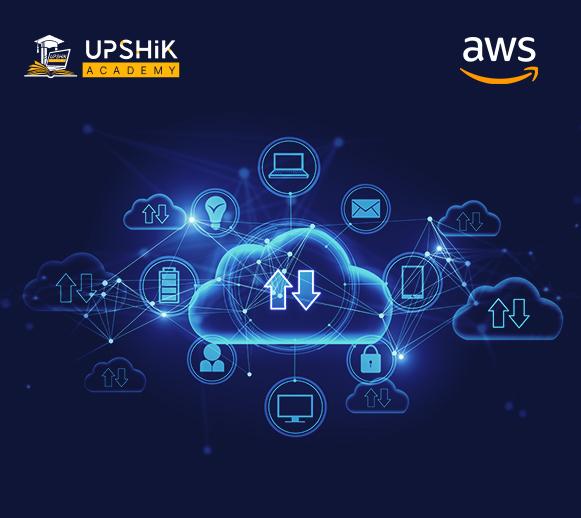
Elevate your cloud career with our hands-on Amazon Web Services (AWS) course. From core services like EC2, S3, and RDS to advanced cloud architecture and security, this course empowers you to design, deploy, and manage scalable cloud solutions. Ideal for …
Elevate your cloud career with our hands-on Amazon Web Services (AWS) course. From core services like EC2, S3, and RDS to advanced cloud architecture and security, this course empowers you to design, deploy, and manage scalable cloud solutions. Ideal for beginners and professionals ready to gain in-demand skills and AWS certification readiness.
About Course:
Launch your cloud career with Upshik Academy’s Pan-India Amazon Web Services (AWS) Training. This end-to-end program guides you through AWS’s core services—Compute, Storage, Database, Networking, Security, and DevOps—using a blend of live online lectures, on-demand videos, and interactive cloud labs. Tailored for learners from Mumbai to Manipur, our curriculum ensures you gain practical, real-world experience architecting and deploying scalable, secure solutions on the world’s leading cloud platform.
What will you Learn
- Learn the foundational principles of AWS, including its global infrastructure, Identity and Access Management (IAM), and the shared responsibility model.
- Compute & Networking: Launch EC2 instances, configure VPCs, load balancers, and auto-scaling groups
- Storage & Databases: Work with S3, EBS, Glacier, RDS, DynamoDB, and data migration strategies
- Security & Compliance: Implement IAM policies, KMS encryption, AWS Shield, and GDPR/GDIC compliance best practices
- Serverless & Containers: Build with Lambda, API Gateway, ECS/EKS, and deploy microservices
- Infrastructure as Code: Automate resource provisioning using CloudFormation and Terraform
- Monitoring & Optimization: Use CloudWatch, CloudTrail, Trusted Advisor, and cost-optimization techniques
- DevOps on AWS: CI/CD pipelines with CodeCommit, CodeBuild, CodeDeploy, and integration with GitHub Actions
- Real-World Projects: Design and deploy three end-to-end solutions—Web App Hosting, Data Lake Implementation, and Serverless API
- 27 Sections
- 380 Lessons
- 30 Days
- AWSCloud25
- 1.1Introduction to Cloud Computing15 Minutes
- 1.2Introduction & Overview
- 1.3What You’ll Need to Get Started
- 1.4Essential Characteristics of CloudComputing
- 1.5Service Models in Cloud Computing
- 1.6Introduction to AWS
- 1.7AWS Account Creation
- 1.8Feetier limitations overview
- 1.9What is cloud computing?
- 1.10Global Infrastructure of AWS
- 1.11AWS Services Walk through-High-level
- 1.12Management Console Walk through
- 1.13Basic Account Management Setting
- 1.14Introduction to Billing Dashboard & CostExplorer
- 1.15What is Regions in AWS?
- 1.16What is Availability Zones in AWS?
- 1.17What used to happen when there was a cloud?
- 1.18What are the advantages of the cloud?
- 1.19Why we should learn only AWS?
- 1.20Service Level Agreement (SLA) of AWS over data and its security
- 1.21How AWS is leading the cloud market?
- 1.22AWS Certifications
- 1.23Gartner Magic Quadrant
- 1.24Setting up Billing Alarm & Budget
- 1.25Exam Blue Print
- EC2(ElasticComputeCloud)49
- 2.1EC2-The Backbone of AWS
- 2.2What is EC2 (ElasticComputeCloud)
- 2.3Scaling features of EC2
- 2.4Limitations of EC2
- 2.5Types of Operating systems
- 2.6Windows and its versions
- 2.7Unix and its flavors
- 2.8Linux and its flavors
- 2.9Instance types
- 2.10Freetire limitations of EC2
- 2.11What is EBS (ElasticBlockStore)?
- 2.12Type sos Storages
- 2.13Difference between Object and Block stores
- 2.14Launching Windows Server
- 2.15Launching Web Server (Apache)
- 2.16Launching Linux Server
- 2.17How to create a simple website?
- 2.18System Ports & Security groups
- 2.19Key pairs (Pem&PPK)
- 2.20Putty Tool installation and configuration
- 2.21Putty Gen Tool installation and configuration
- 2.22Stopping &Terminating EC2 Instances
- 2.23Load Balancer Theory
- 2.24Types of Load Balancer in AWS
- 2.25Load Balancers and health checks
- 2.26User data
- 2.27Web traffic flow
- 2.28Attaching servers to the Load Balancer
- 2.29What is Launch configuration
- 2.30How to configure Launch configuration
- 2.31What is AutoScaling
- 2.32Configuration of AutoScaling
- 2.33Scaleup & Scaledown policies
- 2.34Setting Alarms
- 2.35Status Checks
- 2.36Instance Status Checks
- 2.37Protection from AccidentalTermination
- 2.38Encryption of EBS Volumes
- 2.39Deletion Termination of EBSVolumes
- 2.40Pricing models of EC2 Instances
- 2.41Types of EBS Volumes
- 2.42DifferencebetweenSSD&HDD
- 2.43Upgrading EBS volumes
- 2.44Converting the type of EBS Volumes
- 2.45Attaching & Detaching EBS volumes to EC2 instances
- 2.46Amazon Machine Images(AMIs)
- 2.47Snapshots
- 2.48Creating our own Amazon machine images(AMIs)
- 2.49Deletion sequence as per dependencies
- S3(Simple Storage Service)27
- 3.1S3 (SimpleStorageService)
- 3.2What is S3?
- 3.3What is object storage?
- 3.4Benefits of using S3
- 3.5S3 bucket naming convention
- 3.6Limitations of S3
- 3.7Public & private options
- 3.8Security & Reliability of S3
- 3.9Tiered Storage
- 3.10Static website hosting
- 3.11S3 bucket Tags
- 3.12Cross-Origin Resource Sharing(CORS)
- 3.13Life cycle Management
- 3.14Versioning
- 3.15Encryption
- 3.16BucketPermissions
- 3.17Access control lists
- 3.18Bucketpolicy
- 3.19Storage Classes/Tiers
- 3.20S3 Glacier
- 3.21S3 Storage Classes / Tiers-Prices
- 3.22Transfer Acceleration
- 3.23S3 -Charges
- 3.24Edge locations/EndPoints
- 3.25Cross Region Replication
- 3.26Object Metadata
- 3.27Summary
- IAM(Identity & Access Management)18
- 4.1Introduction to Identity & Access Management
- 4.2Components of IAM
- 4.3Root Access Keys
- 4.4Setting up a password rotation policy
- 4.5Centralized & Sharing access
- 4.6Creating and Managing Users & Groups
- 4.7Creating and Managing IAM Policies / Permissions
- 4.8In linePolicies
- 4.9Managed Policies
- 4.10Custom Policies
- 4.11How to Generate Own Policy
- 4.12How to recover lost passwords
- 4.13Graphical (GUI) & Command line (CLI)access
- 4.14Roles and their use cases
- 4.15Multi-Factor Authentication -[MFA]
- 4.16Security Features in IAM
- 4.17Create A Billing Alarm
- 4.18Best Practices of IAM
- AWSCLI(Command Line Interface)13
- 5.1AWS CLI (Command Line Interface)
- 5.2What is AWSCLI?
- 5.3Advantages of CLI
- 5.4How to access AWS through CLI
- 5.5How to generate root access keys?
- 5.6AWS CLI package installation
- 5.7Using CLI through Windows & Linux servers
- 5.8Access key & Secret keys
- 5.9Launching EC2 instances through AWS CLI
- 5.10Creating S3 buckets through AWS CLI
- 5.11Managing IAM users through AWS CLI
- 5.12Managing IAM groups through AWS CLI
- 5.13Using IAM Roles in AWS CLI
- VPC(Virtual Private Cloud)45
- 6.1VPC (Virtual Private Cloud)
- 6.2What is Network?
- 6.3Network components
- 6.4Network topology
- 6.5Network Media
- 6.6Network Interface Card
- 6.7Network protocol
- 6.8TCP/IPVsUDP ports
- 6.9IP Addressing
- 6.10Classes of IP addresses
- 6.11Reserved IP Addresses
- 6.12CIDR(Classless Inter-Domain Routing)
- 6.13Loopback IP Range
- 6.14Subnet/Subnet Mask
- 6.15Public IP & Private IP
- 6.16Introduction to Virtual Private Cloud -VPC
- 6.17Build Your Own Custom VPC
- 6.18Assigning IP addresses to VPC
- 6.19What is Subnet?
- 6.20Public & Private Subnets
- 6.21Enabling Public IP
- 6.22Internet Gateway
- 6.23VPC Routers
- 6.24WebServer & Database Server in VPC
- 6.25Restricting ports to specific users
- 6.26Bastion server/Jumpserver
- 6.27NAT (Network Address Translation)Gateway
- 6.28What is Elastic IP?
- 6.29Public IPVs Elastic IPVs Private IP
- 6.30My SQL port connection
- 6.31NACL (Network Access Control Lists)
- 6.32Inbound & Outbound rules
- 6.33Statefull & Stateless
- 6.34Ephemeral ports
- 6.35Security Groups Vs NACLs
- 6.36VPC Peering
- 6.37Peering Limitations
- 6.38What is transitive peering
- 6.39VPC Flow logs
- 6.40VPC Flow Logs limitations
- 6.41Exempted IP addresses from Flow logs
- 6.42What is Instance Metadata?
- 6.43VPC End Points
- 6.44VPC Clean Up
- 6.45VPC Summary
- Route5320
- 7.1Route53
- 7.2DNS
- 7.3What is DNS (Domain Name System)
- 7.4Purpose of DNS
- 7.5Types of Domains
- 7.6How to buy Domains
- 7.7Domain-sellers
- 7.8IANA (Internet Assigned Numbers Authority)
- 7.9Route 53 Register A Domain Name
- 7.10How Route 53 Works
- 7.11Setup Our EC2 Instances Lab
- 7.12Health Checks in Route 53
- 7.13Alarms and Notifications in Route 53
- 7.14Different Routing Policies
- 7.15Simple Routing Policy
- 7.16Weighted Routing Policy
- 7.17Latency Routing Policy
- 7.18Failover Routing Policy
- 7.19Geo location Routing Policy
- 7.20DNS Exam Tips
- RDS(Relational Database Service)17
- 8.1Databases on AWS
- 8.2What is a Database
- 8.3What is RDS (Relational Database Service)
- 8.4What is SQL
- 8.5What is No SQL
- 8.6What is a Data warehouse
- 8.7AWS supporting Databases
- 8.8Create our first RDS Instance(MySQL)
- 8.9RDS Back-ups
- 8.10Automated Backups
- 8.11DB Snapshots
- 8.12Database Retention period
- 8.13DB Transactional Logs
- 8.14Multi-AZ
- 8.15Read Replicas
- 8.16Copy snapshot
- 8.17Migrate snapshot
- DynamoDB6
- Redshift6
- Elasticache5
- CloudWatch18
- 12.1Cloud Watch
- 12.2Monitoring, Metrics and Analysis
- 12.3Cloud Watch Introduction
- 12.4What is monitoring?
- 12.5Why we should monitor?
- 12.6What is the need of a monitoring tool?
- 12.7Default Monitoring
- 12.8Detailed Monitoring
- 12.9Create Alarms
- 12.10Create Billing Alarms
- 12.11Cloud Watch graphs
- 12.12How to create a dashboard?
- 12.13Line Graph
- 12.14stacked area graph
- 12.15Number Graph
- 12.16Text Graph
- 12.17Monitoring EC2
- 12.18Monitoring RDS
- EFS(Elastic File System)7
- SNS (Simple Notification Service)10
- SQS(Simple Queue Service)9
- SES(Simple Email Service)4
- Cloud Formation9
- ElasticBeanstalk6
- Snowball5
- CloudFront8
- Cloud Trail5
- Elastic Transcoder3
- Whitepapers22
- 23.1White papers & The Well Architected Framework
- 23.2Security
- 23.3Reliability
- 23.4Performance Efficiency
- 23.5Cost Optimization
- 23.6Operational Excellence
- 23.7Service Models
- 23.8IAAS(InfrastructureAsAService)
- 23.9PAAS(PlatformAsAService)
- 23.10SAAS(SoftwareAsAService)
- 23.11Security Credentials
- 23.12Amazon Corporate Segregation
- 23.13Shared Responsibility Model
- 23.14AWS Responsibility
- 23.15User Responsibility
- 23.16Storage De-commissioning
- 23.17Scale up & Scaledown
- 23.18Scale Out & ScaleIn
- 23.19De-Coupling mechanism
- 23.20Types of Elasticity
- 23.21Compliance
- 23.22Summary
- AWS Certifications8
- Lambda12
- 25.1What is Lambda?
- 25.2Architecture of Lambda
- 25.3Function As A Service(FAAS)
- 25.4What is a Lambda Function?
- 25.5Different ways of creating Lambda Function
- 25.6Creating a custom Lambda Function from scratch using Python
- 25.7Deploying custom Lambda Function for automation
- 25.8What is a Trigger?
- 25.9Integrating Lambda with Cloudwatch
- 25.10What is Cronjob?
- 25.11Use cases of Lambda
- 25.12Pricing models of Lambda
- Terraform15
- 26.1What is terraform
- 26.2What are the advantages of terraform
- 26.3why we have to use Terraform
- 26.4What is ICAC?
- 26.5What are the advantages of IAC?
- 26.6list of cloud providers
- 26.7what are the cloud providers support terraform
- 26.8How to download terraform software
- 26.9Terraform installation on windows & LinuxServers
- 26.10How to set terraform path temporarily and permanently
- 26.11What is IAM in AWS?
- 26.12How to create IAM user?
- 26.13How to launch windows instance
- 26.14How tolaunchLinuxinstance
- 26.15Creation of S3 bucket
- Projects8
You might be intersted in
Welcome to UpShik Academy, your premier online EdTech platform dedicated to empowering students and professionals with cutting-edge digital learning and skill development.
- +91 73960 67744
- contact@upshikacademy.com
Quick Links
Address
- Viswa Bharati Enclave 2nd Floor, Bairagi patteda, Tirupati, Andhra Pradesh 517501
- No 5, 2nd Cross Rd, near Manyata Tech Park Road, P&T Layout, Bengaluru, Karnataka 560077.
- Gronnvej 268, 2th Sorgenfri Virum -2830 Copenhagen capital region Denmark.
Copyright © Upshik Academy | Developed By ZenWareIT Software Solutions LLP

